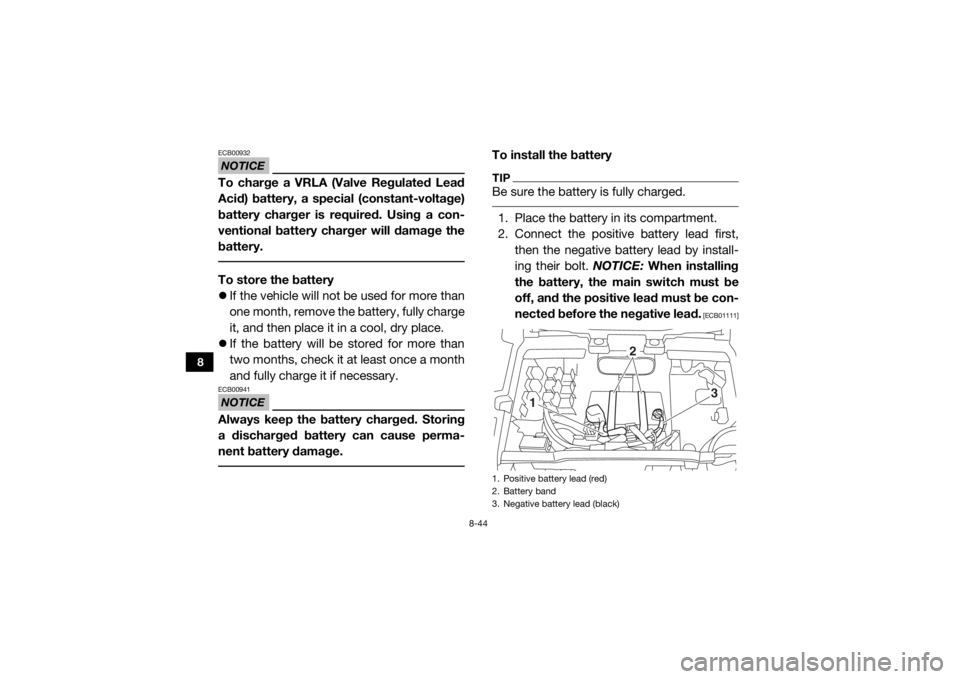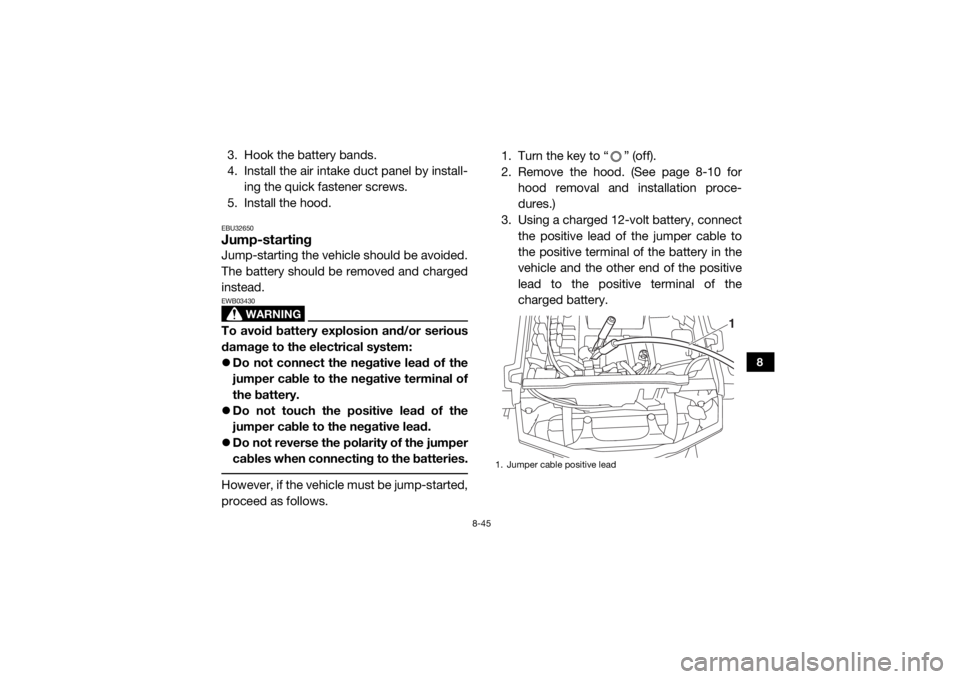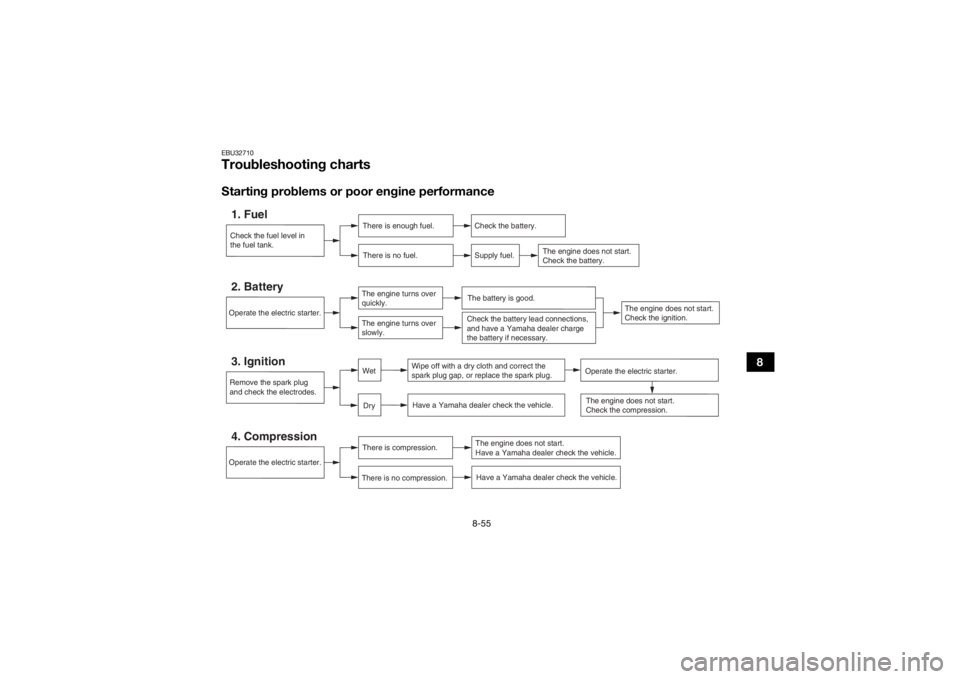Page 142 of 172

8-42
8
tilled water. However, the battery lead con-
nections need to be checked and, if
necessary, tightened.
WARNING
EWB03410Avoid battery contact with skin, eyes, or
clothing. Shield eyes when working near
batteries. Keep out of reach of children.
You could be poisoned or severely burned
by the sulfuric acid in battery electrolyte. In
case of accidental contact with battery
electrolyte:
EXTERNAL: Flush with water.
INTERNAL: Drink large quantities of water
or milk. Follow with milk of magnesia,
beaten egg, or vegetable oil. Get prompt
medical attention.
EYES: Flush with water for 15 minutes and
get prompt medical attention.
WARNING
EWB03420Batteries may produce explosive gases.
Ventilate when charging or using in a
closed space. Keep batteries away from
sparks, flames, cigarettes, or other sourc-
es of ignition. To remove the battery
1. Turn the key to “ ” (off).
2. Remove the hood. (See page 8-10 for hood removal and installation proce-
dures.)
3. Remove the air intake duct panel by re-
moving the quick fastener screws.
UB427AE0.book Page 42 Monday, May 18, 2015 9:17 AM
Page 143 of 172
8-43
8
4. Unhook the battery bands.
5. Disconnect the negative battery lead first,then the positive battery lead by remov-
ing their bolt. NOTICE: When removing
the battery, the main switch must be
off, and the negative lead must be dis-
connected before the positive lead.
[ECB01002]
6. Pull the battery out of its compartment.
To charge the battery
Have a Yamaha dealer charge the battery as
soon as possible if it seems to have dis-
charged. Keep in mind that the battery tends
to discharge more quickly if the vehicle is
equipped with optional electrical accessories.
1. Quick fastener screw
2. Air intake duct panel
2
1
1. Positive battery lead (red)
2. Battery band
3. Negative battery lead (black)
2
1
3
UB427AE0.book Page 43 Monday, May 18, 2015 9:17 AM
Page 144 of 172

8-44
8
NOTICEECB00932To charge a VRLA (Valve Regulated Lead
Acid) battery, a special (constant-voltage)
battery charger is required. Using a con-
ventional battery charger will damage the
battery. To store the battery
If the vehicle will not be used for more than
one month, remove the battery, fully charge
it, and then place it in a cool, dry place.
If the battery will be stored for more than
two months, check it at least once a month
and fully charge it if necessary.NOTICEECB00941Always keep the battery charged. Storing
a discharged battery can cause perma-
nent battery damage.
To install the batteryTIPBe sure the battery is fully charged. 1. Place the battery in its compartment.
2. Connect the positive battery lead first,
then the negative battery lead by install-
ing their bolt. NOTICE: When installing
the battery, the main switch must be
off, and the positive lead must be con-
nected before the negative lead.
[ECB01111]
1. Positive battery lead (red)
2. Battery band
3. Negative battery lead (black)
2
1
3
UB427AE0.book Page 44 Monday, May 18, 2015 9:17 AM
Page 145 of 172

8-45
8
3. Hook the battery bands.
4. Install the air intake duct panel by install-ing the quick fastener screws.
5. Install the hood.EBU32650Jump-startingJump-starting the vehicle should be avoided.
The battery should be removed and charged
instead.
WARNING
EWB03430To avoid battery explosion and/or serious
damage to the electrical system:
Do not connect the negative lead of the
jumper cable to the negative terminal of
the battery.
Do not touch the positive lead of the
jumper cable to the negative lead.
Do not reverse the polarity of the jumper
cables when connecting to the batteries. However, if the vehicle must be jump-started,
proceed as follows. 1. Turn the key to “ ” (off).
2. Remove the hood. (See page 8-10 for
hood removal and installation proce-
dures.)
3. Using a charged 12-volt battery, connect the positive lead of the jumper cable to
the positive terminal of the battery in the
vehicle and the other end of the positive
lead to the positive terminal of the
charged battery.
1. Jumper cable positive lead
1
UB427AE0.book Page 45 Monday, May 18, 2015 9:17 AM
Page 146 of 172
8-46
8
4. Connect the negative lead of the jumpercable to the negative terminal of the
charged battery and the other end of the
negative lead to an unpainted metal sur-
face of the frame of the vehicle to be
started.
5. Start the engine. (Refer to “Starting the engine” on page 6-2.)
6. After the engine starts, disconnect the
negative lead of the jumper cable from
the frame and charged battery, and then disconnect the positive lead of the jump-
er cable from the charged battery and the
battery in the vehicle.
7. Install the hood.
EBU33100Fuse replacementThe main fuse, the fuel injection system fuse,
the EPS fuse, and the fuse box are located
under the hood. (See page 8-10 for hood re-
moval and installation procedures.)
1. Jumper cable negative lead
1
UB427AE0.book Page 46 Monday, May 18, 2015 9:17 AM
Page 155 of 172

8-55
8
EBU32710Troubleshooting chartsStarting problems or poor engine performanceCheck the fuel level in
the fuel tank.1. Fuel
There is enough fuel.
There is no fuel.
Check the battery.
Supply fuel.
The engine does not start.
Check the battery.
Operate the electric starter.4. Compression
There is compression.
There is no compression.
The engine does not start.
Have a Yamaha dealer check the vehicle.Have a Yamaha dealer check the vehicle.
Remove the spark plug
and check the electrodes.3. Ignition
Wipe off with a dry cloth and correct the
spark plug gap, or replace the spark plug. Have a Yamaha dealer check the vehicle.
The engine does not start.
Check the compression.
Operate the electric starter.2. Battery
The engine turns over
quickly.
The engine turns over
slowly.
The battery is good.
DryWet
Operate the electric starter.
Check the battery lead connections,
and have a Yamaha dealer charge
the battery if necessary.
The engine does not start.
Check the ignition.
UB427AE0.book Page 55 Monday, May 18, 2015 9:17 AM
Page 159 of 172
9-3
9
5. Tie a plastic bag over the exhaust pipeoutlet to prevent moisture from entering.
6. If storing in a humid or salt-air atmo- sphere, coat all exposed metal surfaces
with a light film of oil. Do not apply oil to
any rubber parts or the seat covers.
7. Remove the battery and charge it. Store it in a dry place and recharge it once a
month. Do not store the battery in an ex-
cessively warm or cold place [less than 0
°C (30 °F) or more than 30 °C (90 °F)].
Use of fuel stabilizer and conditioner elimi-
nates the need to drain the fuel system. Con-
sult a Yamaha dealer if the fuel system needs
to be drained.
UB427AE0.book Page 3 Monday, May 18, 2015 9:17 AM
Page 164 of 172
10-5
10
Charging system:AC magnetoBattery:Model:
U1-H11L
Voltage, capacity: 12 V, 28.0 AhHeadlight:Bulb type:
Halogen bulbBulb voltage, wattage × quantity:Headlight:
12 V, 35.0/35.0 W × 2
Tail/brake light:
12 V, 5.0/21.0 W × 2
Neutral indicator light: LED
Reverse indicator light: LED
Coolant temperature warning light:
LED
Engine trouble warning light: LED
Park indicator light: LED
High-range indicator light:
LED
Low-range indicator light: LED
Differential gear lock indicator light: LED EPS warning light:
LED
Helmet/Seat belt indicator light: 14 V, 0.85 W × 2
Fuses:Main fuse:
40.0 A
Fuel injection system fuse: 10.0 A
EPS fuse:
40.0 A
Headlight fuse: 15.0 A
Signaling system fuse: 10.0 A
Ignition fuse:
10.0 A
Auxiliary DC jack fuse: 10.0 A
Backup fuse: 10.0 A
Four-wheel-drive motor fuse:
10.0 A
Radiator fan motor fuse: 25.0 A
UB427AE0.book Page 5 Monday, May 18, 2015 9:17 AM